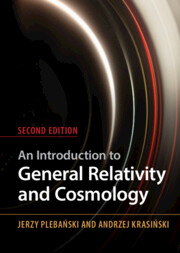Book contents
- Frontmatter
- Contents
- The scope of this text
- Preface to the second edition
- Acknowledgments
- 1 How the theory of relativity came into being (a brief historical sketch)
- Part I Elements of differential geometry
- Part II The theory of gravitation
- 12 The Einstein equations and the sources of a gravitational field
- 13 The Maxwell and Einstein–Maxwell equations and the Kaluza–Klein theory
- 14 Spherically symmetric gravitational fields of isolated objects
- 15 Relativistic hydrodynamics and thermodynamics
- 16 Relativistic cosmology I: general geometry
- 17 Relativistic cosmology II: the Robertson–Walker geometry
- 18 Relativistic cosmology III: the LemaÎtre–Tolman geometry
- 19 Relativistic cosmology IV: simple generalisations of L–T and related geometries
- 20 Relativistic cosmology V: the Szekeres geometries
- 21 The Kerr metric
- 22 Relativity enters technology: the Global Positioning System
- 23 Subjects omitted from this book
- 24 Comments to selected exercises and calculations
- References
- Index
15 - Relativistic hydrodynamics and thermodynamics
from Part II - The theory of gravitation
Published online by Cambridge University Press: 30 May 2024
- Frontmatter
- Contents
- The scope of this text
- Preface to the second edition
- Acknowledgments
- 1 How the theory of relativity came into being (a brief historical sketch)
- Part I Elements of differential geometry
- Part II The theory of gravitation
- 12 The Einstein equations and the sources of a gravitational field
- 13 The Maxwell and Einstein–Maxwell equations and the Kaluza–Klein theory
- 14 Spherically symmetric gravitational fields of isolated objects
- 15 Relativistic hydrodynamics and thermodynamics
- 16 Relativistic cosmology I: general geometry
- 17 Relativistic cosmology II: the Robertson–Walker geometry
- 18 Relativistic cosmology III: the LemaÎtre–Tolman geometry
- 19 Relativistic cosmology IV: simple generalisations of L–T and related geometries
- 20 Relativistic cosmology V: the Szekeres geometries
- 21 The Kerr metric
- 22 Relativity enters technology: the Global Positioning System
- 23 Subjects omitted from this book
- 24 Comments to selected exercises and calculations
- References
- Index
Summary
The description of motion of a continuous medium in curved spacetime is introduced and related to the corresponding Newtonian description. Expansion, acceleration, shear and rotation of the medium are defined and interpreted. The Raychaudhuri equation and other evolution equations of hydrodynamical quantities are derived. A simple example of a singularity theorem is presented. Relativistic thermodynamics is introduced and it is shown that a thermodynamical scheme is guaranteed to exist only in such spacetimes that have an at least 2-dimensional symmetry group.
Keywords
- Type
- Chapter
- Information
- An Introduction to General Relativity and Cosmology , pp. 211 - 222Publisher: Cambridge University PressPrint publication year: 2024

